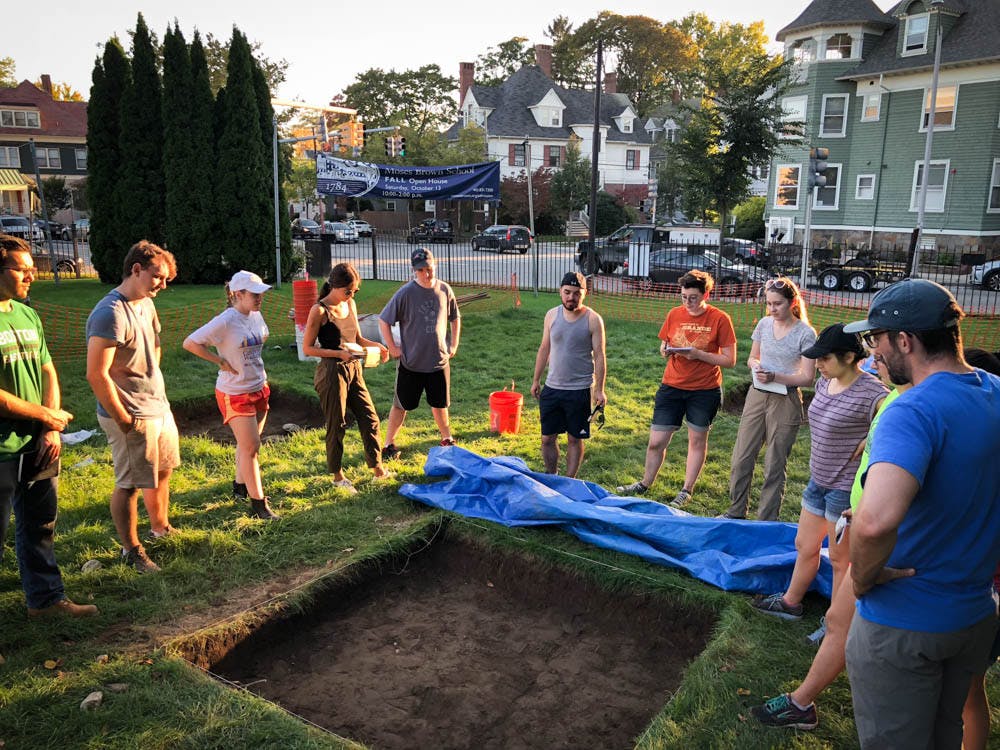At first glance, the soccer field at Moses Brown School contains little more than open space, two goals and a few stray balls. But underneath the field at the intersection of Hope and Lloyd Streets lies the ruins of a house dating back to 1884. Demolished in 1939, the house once belonged to the Sack family, longtime Providence residents. The ruins now serve as the dig site for the students of ARCH 1900: “Archaeology of College Hill.”
In this unique course, which was originally offered in 2006, students get the chance to conduct an archaeological dig without having to fly to a remote site or pay for travel expenses, said Alex Marko GS, who teaches the class. Most people get their first hands-on experience with archaeology in a field school on a one- to two-month assignment, but this class makes the field more accessible, Marko added. With hands-on experience, the course hopes to teach archaeological techniques and give students a better understanding of the history of the University’s surroundings, he said. “We want to use objects and context to try to understand people,” he added.
After digging for several weeks during the first half of the course, students learn how to analyze archaeological artifacts in the lab. Over the years, students have explored several spots close to the classroom, including the Quiet Green and the First Baptist Church of America.
Four years ago, students combed through housing records at the Rhode Island Historical Society and found evidence that the soccer fields at Moses Brown contained much more than what immediately met the eye. Multiple documents provided evidence that the site contained the ruins of the Sack family house, so the group began digging. After four years of work at the site, the exact locations of this year’s dig are new. Previous digs from past students indicated that the chosen spots held remains of the house’s foundation and possibly more. Students first marked off the area, then carefully peeled back decades of dirt class after class.
After digging for several weeks this fall, students have uncovered extensive remains at the site. Hours of digging, scraping and sifting through dirt have revealed significant portions of the house’s foundation, decorative tiles and dozens of nails that once held the home in place. In a flashy surprise, Yale Friend ’19, a student in the course this year, uncovered an inscribed ring at the site. Though the class has been unable to determine the ring’s origins, they are beginning to run lab experiments to unlock its mysteries. While they wait to analyze it in the lab, class members speculate that the object is either a class ring or commemorative of a special occasion.
The digs have been conducted almost entirely by the students in Marko’s course, but the group invited sixth grade students from Moses Brown to visit the site as part of an effort to engage the students studying only a few hundred yards away. The course supports community interaction and participation in many other ways as well. Students are encouraged to have a final project that is “outward-facing” and makes the findings accessible — such as a presentation at a local school or conference, Marko said. A community dig day in October also helped bring local residents to the site to uncover artifacts for themselves. The class will present some of its findings in February alongside another archaeology class, ARCH 0317: “Heritage in the Metropolis: Remembering and Preserving the Urban Past,” as part of Providence’s Year of the City, which highlights the centuries of rich Providence history.
Many of the course’s 13 students had little or no previous experience in archaeology prior to enrollment, Marko said. They came from diverse academic backgrounds but all wanted to learn about archaeology in a hands-on way, he added.
Friend said that he was particularly excited about the opportunity to take a class that would let him get outside for a few hours during the week. “I love being outside, I love working with my hands and this gives me a break from normal lab work,” he said.
Sasha Pinto ’21 enjoys learning about what an archaeologist does to uncover artifacts. “I had no concept of what an archaeologist did,” she said. “It gives you an appreciation for what’s underneath you everyday.”
The class also lets students learn about history from perspectives that are not always covered in textbooks, especially those that are typically minimized in historical narratives such as women and people of color, said Rachel Gold ’19, a former Herald senior staff writer. “We can fill in a lot of gaps in the textual record,” she described. “Other than the fun of digging up the dirt, there’s a potential to learn about what the artifacts are saying together with what the texture of the dirt is saying,” she added.





